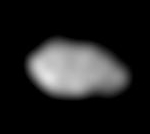Metis (moon)

Image of Metis was taken by Galileo's solid-state imaging system between November 1996 and June 1997
|
|
| Discovery | |
|---|---|
| Discovered by | S. Synnott |
| Discovery date | 4 March 1979 |
| Orbital characteristics | |
| Periapsis | 127974 km |
| Apoapsis | 128026 km |
|
Mean orbit radius
|
128000 km (1.792 RJ) |
| Eccentricity | 0.0002 |
| 0.294780 d (7 h, 4.5 min) | |
|
Average orbital speed
|
31.501 km/s |
| Inclination | 0.06° (to Jupiter's equator) |
| Satellite of | Jupiter |
| Physical characteristics | |
| Dimensions | 60 × 40 × 34 km3 |
|
Mean radius
|
21.5±2.0 km |
| Volume | ≈ 42700 km3 |
| Mass | ~3.6×1016 kg |
|
Mean density
|
~0.86 g/cm3 |
| synchronous | |
| zero | |
| Albedo | 0.061±0.003 |
| Temperature | ≈ 123 K |
Metis (/ˈmiːtᵻs/; Greek: Μήτις), also known as Jupiter XVI, is the innermost moon of Jupiter. It was discovered in 1979 in images taken by Voyager 1, and was named in 1983 after the first wife of Zeus, Metis. Additional observations made between early 1996 and September 2003 by the Galileo spacecraft allowed its surface to be imaged.
Metis is tidally locked to Jupiter, and its shape is strongly asymmetrical, with one of the diameters being almost twice as large as the smallest one. It is also one of the two moons known to orbit Jupiter in less than the length of Jupiter's day, the other being Adrastea. It orbits within the main ring of Jupiter, and is thought to be a major contributor of material to the rings.
Metis was discovered in 1979 by Stephen P. Synnott in images taken by the Voyager 1 probe and was provisionally designated as S/1979 J 3. In 1983 it was officially named after the mythological Metis, a Titaness who was the first wife of Zeus (the Greek equivalent of Jupiter). The photographs taken by Voyager 1 showed Metis only as a dot, and hence knowledge about Metis was very limited until the arrival of the Galileo spacecraft. Galileo imaged almost all of the surface of Metis and put constraints on its composition by 1998.
...
Wikipedia
